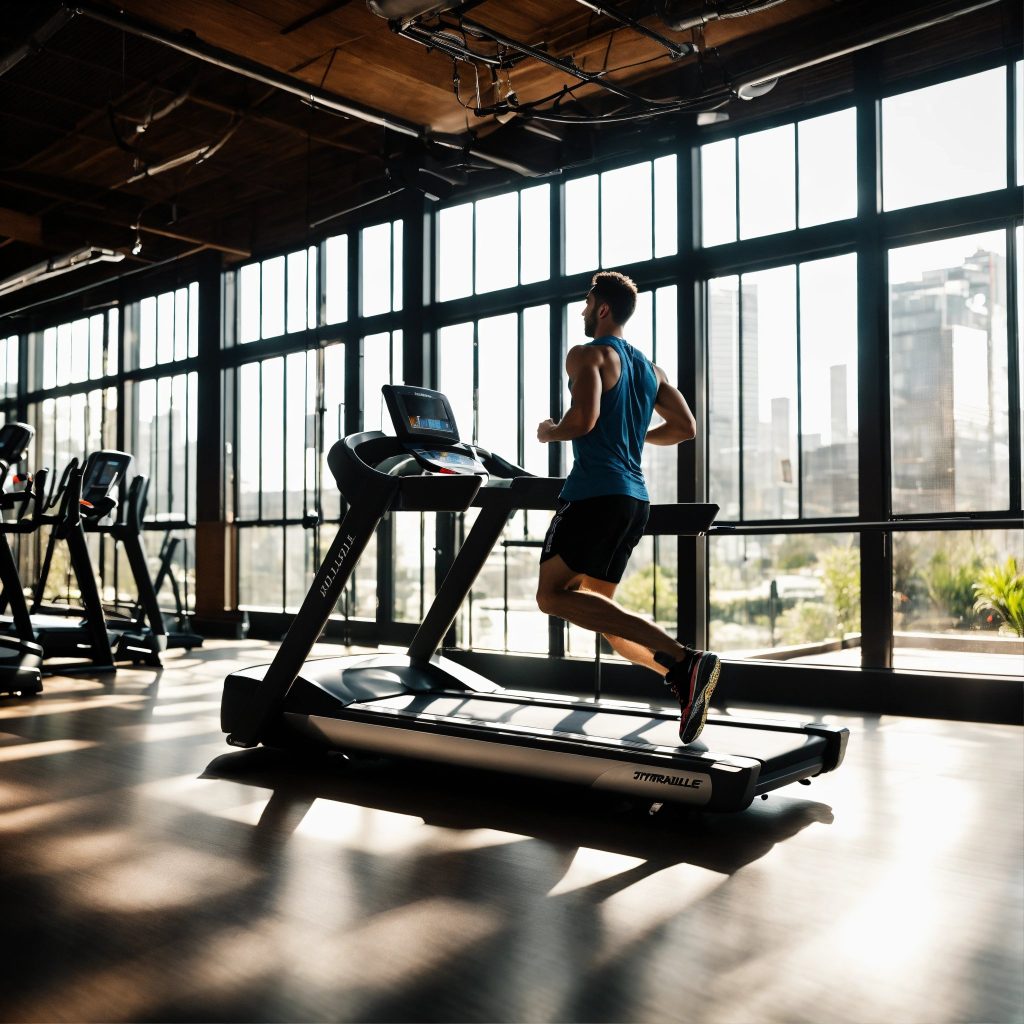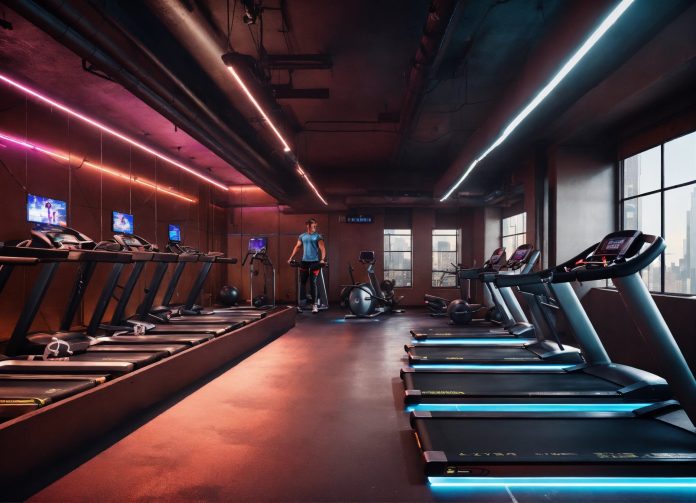Orangetheory Fitness (OTF) is a high-intensity interval training studio franchise that offers group workout classes focused on cardiovascular and strength training. One aspect that sets OTF apart from other boutique fitness studios is it’s utilization of wearable heart rate monitor technology to track exertion and calories burned during sweat sessions. Members strap on a heart rate monitor chest strap that connects wirelessly to screens in the workout room, allowing them to monitor their heart rate in real time as coaches guide them through blocks of treadmill running, indoor rowing and floor exercises.
One of the signature benchmark workouts at Orangetheory is the 1 Mile Run. Typically performed a few times per year, this fitness test challenges members to clock their fastest possible indoor mile time. For many OTF devotees, PRs (personal records) on the 1 Mile Benchmark are hard-fought badges of pride displayed on workout summaries next to splat points and calories torched.
Race Day Adrenaline in a Group Fitness Class
While hardcore runners may scoff at the idea of an all-out effort on a treadmill rather than on an outdoor track or road course, the OTF 1 Mile run brings an electric atmosphere that mimics the excitement of a road race. The hype leading up to the benchmark mile at your home studio is palpable, with coaches reminding members for weeks to gear up for the challenge. Special spirit days and prize giveaways also help build buzz and morale.
When Mile Benchmark day arrives, members arrive early to warm up and psyche themselves up. Upbeat music blasts as coaches review treadmill settings and offer a last-minute pep talk before the gun goes off. “You’re going to want to quit at least three times during this mile,” one coach warned, “but I’m telling you that you CAN do this! Push hard and leave it all on that treadmill.”
The studio lights even dim when it’s time to run, as if the start gun has sounded at a track meet under stadium lights. Members mount their treadmills and grab the handlebar, ready a fast, furious pace. Fueled by adrenaline, the room moves in solidarity toward one simple goal: Run faster for 60 seconds… now 59… now 58… Surrounded by the labored breathing and foot strikes of those running alongside you, it’s impossible not to dig deeper.
Tracking Your Progress

One aspect that makes the 1 Mile Benchmark such a powerful motivator is the ability to tangibly track progress over time. Orangetheory stores historical workout data so members can view their previous mile times as far back as 2016 when the studios first opened. Seeing that number black-and-white elicits a competitive spark for manyreturning runners hoping to set new PRs.
The front desk staff writes the day’s mileage Attempts and times on a whiteboard so members can glance up from their treads to see how they stack up against the rest of the class in real time. Coaches stand close by to report milestone splits at the 0.25, 0.5, 0.75 marks… while shouting out encouragement to keep legs churning.
As runners cross the finish line, times are immediately printed onto sweaty workout summaries, providing swift confirmation of success. High fives, chest bumps and proud whoops echo around the room as members catch their breath and check if their hard work paid off with new PRs.
Priming Your Body to Peak

In the days leading up to the Benchmark Mile, coaches stress the importance of adequate training and proper fueling. In preparation, many members scale back their workouts slightly while intentionally hydrating and carb-loading to ensure their bodies perform optimally on race day.
24 hours before the run, coaches recommend completing an easy 30-minute workout and foam rolling tight muscles. Proper sleep and a hearty meal high in carbohydrates the night before also helps runners arrive well-rested and fueled with glycogen to spare. OTF coaches also emphasize staying well hydrated in the 12-24 hour period prior to the intense mile effort.
When mile day arrives, runners still warm up as usual with a brisk treadmill walk followed by some steady base pace jogging. Dynamic stretches help activate muscles soon to be called upon during the brutal endurance effort. Jogging in place and grapevines continue raising the heart rate right up until toes line up on tread tapes signaling the start.
Psychology of Pacing

Mentally, the opening 0.25 mile split often proves the most challenging. Adrenaline fuels most runners out of the gates at an overly ambitious clip that simply cannot be sustained. Maintaining composure early on takes incredible discipline and self-control.
The voice inside starts questioning almost immediately… have I already gone out too fast? Will I completely hit the wall later? Should I scale it back? The mental tug-of-war is intense, making this segment as much a test of focus as it is physical endurance.
Comfort often returns around the 0.5 mark as breathing stabilizes and an even pace feels locked in. Still, distress signals start firing around 0.75 miles when the legs and lungs scream for mercy. Runners who banked time upfront by resisting the urge to sprint early can cash it in here. Those who went out too aggressively often crumble.
The final 0.25 mile becomes sheer survival. Members who dove too deep into oxygen debt struggle mightily as their treadmills feel stuck in quicksand. Each stride is weighted as they watch the clock tick by at an agonizing crawl. Meanwhile, those who conserved just enough energy through proper pacing shift to their highest gears. Faces twist and contort with effort while the studio roars approval.
Ultimately the psychology of patience and restraint early on plays a major role in benchmark performance. Your brain helps determine success on race day as much as your physiological conditioning. Staying mentally checked in prevents costly physical breakdowns.
Pushing Through the Pain

While smashing PRs and celebrating together feeds souls, the 1 Mile Benchmark also serves another critical purpose – exposing physical weaknesses. Performance often hinges as much on mental grit to withstand discomfort as raw running talent.
As coach Brody philosophized after the last benchmark, “Racing is really about managing pain inevitable in middle distances. How much distress can you deal with before you disengage and back off the throttle?”
He’s right. Members train hard at OTF yet rarely run at full tilt for 8 entire minutes like the ensuing battle against the treadmill. The searing lungs and tingling legs overwhelm many unaccustomed to managing such suffering. Though treadmills belts keep whirling along steadily, minds and bodies eventually revolt.
Watching runners double over wheezing after sudden stops short of the mile brings realization that one mile represents the outer limit of speed they can tolerate. And perhaps scarce distance remains before reaching their quitting point when faced with enough pain.
“If you think you’re done after just 0.75 miles, what happens when life inevitably hurts MORE one day?” coach Brody mused. The Mile Benchmark tests resolve and exposes mental toughness or brittleness within. Do you crumble or carry on when pushed to the brink? Can you take the heat or do you get out of the kitchen?
True Potential

After the expertise of properly pacing and fueling come more intrinsic factors that ultimately determine how fast members run. Raw talent, genetics, biomechanics and physiology clearly not all equal. Some members walk in the door seemingly bred to fly on treadmills.
Take Matt, a long striding 31-year-old who looks like he was peeled off a Nike “Just Do It” poster. While others strain red-faced to hold sub 8:00 miles, Matt floats comfortably below six-minute pace. Jawlines drop every time Matt steps atop a treadmill in his Vaporfly Next% shoes and nonchalantly clocks a 4:32 mile before jogging out the studio hardly short of breath.
But while physical gifts provide clear advantages, rarely does anyone tap into 100% of their bodie’s potential without honing mental discipline. And without proper coaching to prime peak performance on key dates… after patiently building fitness.
This explains why some relatively new members PR by only a few seconds despite soaring motivation. Like revving a souped-up racer with rotten brakes. Regardless what lies under the hood, controlled speed matters most. Precision coaching molds middling talent into excellence.
So on Mile Benchmark days, members essentially race against prior versions of themselves. The miles mark progress unlocking genetic ceilings step-by-step. Inch by inch, members earn breakthroughs through committing to the relentless training process. Until someday, they turn around and suddenly realize fast they have become.
Why it All Matters

Ultimately the significance of testing one’s mettle against the clock at Orangetheory boils down to becoming one percent better. While the studio promises more energy, less weight and better health… the Mile Benchmark distills improvement to a single metric.
Your last best effort preserved forever as proof of progress. A north star to chart just how far you have traveled since first walking through the red doors as the old slower version of yourself. The new PR representing the latest chapter of an ever-unfolding journey toward your best self.
So whether you finish 400 meters or a full 1600 meters on 1 Mile day, the distance itself matters less than courage shown in chasing greatness. The wheezing and wobbly legs fade over hours… but respect earned from others (and yourself) lasts forever.
May the burn in your lungs and fire in your heart… sparked again soon when another Benchmark Mile rolls around.
Hidden Health Benefits

While the Orangetheory Mile Benchmark serves as a fitness test and marker of improved performance, attempting a all-out effort also comes with little known health perks.
Increased Mitochondria Density
Pushing your body to it’s absolute limit stimulates mitochondrial biogenesis – the growth of new mitochondria in your muscle cells. Since mitochondria act as the “powerhouses” that burn carbohydrates and fat for energy, extra mitochondria allows your muscles to utilize oxygen and generate ATP more efficiently. This leads to benefits like enhanced endurance, faster recovery between workouts, increased fat burning potential and protection against muscle atrophy as you age.
So by overriding your body’s safety mechanisms with an intense, sustained effort like the Mile Benchmark, you prompt it to grow and strengthen at a cellular level. These structural adaptations make you fitter so you can handle training at higher intensities in the future. It’s the concept of “what doesn’t kill you, makes you stronger” played out inside your cells.
Surge in Human Growth Hormone
Running all-out for ~8 minutes also stimulates a pronounced spike in Human Growth Hormone (HGH) production which promotes recovery by regulating fluid levels in joints and connective tissue. Bonus: elevated HGH levels post-workout have also been shown to lower LDL cholesterol for up to a day – reducing risk of heart disease.
Elevated Afterburn
By getting your heart rate into the anaerobic zone for an extended period, you incinerate through immediate energy stores faster than oxygen can be delivered. This taps into the “afterburn effect” where your body continues scorching calories at an accelerated clip after exercise while it recovers.
This means revving your metabolic engine into redline through intense efforts like the Mile Benchmark catalyzes more total fat burning. Even while you are passed out on the couch hours later, your cells are still utilizing extra oxygen and energy to recoup depleted fuel stores.
While the white-knuckle misery of running at 10K-effort for ~8 minutes may not sound enticing for it’s health benefits alone… just know each time you dig as deep as possible, your body responds by growing stronger so next time feels relatively easier!
FAQs
The Mile Benchmark is typically scheduled four times per year, once each season. Many locations run the Mile Benchmark in January, April, July and October. Specific benchmark calendars vary a bit by individual franchise location.
Yes, you can hold lower speeds and walk as needed during your mile. Coaches encourage you to keep moving the entire time if possible, even if at walking pace toward the end as fatigue sets in. Usually 15 minutes of walking recovery is built into the workout template after the run.
Participation is strongly encouraged for the fitness insights, but ultimately optional if injured or otherwise unable to complete the test. Members can opt to simply not login to a treadmill computer and record a mile or log mileage shorter than 1 mile. Talk to your head coach if concerned about suitability for any reason.
There are slight differences in treadmill models used across the over 1,300 Orangetheory locations globally. Models manufactured by Woodway, Landice and True Fitness are typically used to allow for speed adjustments in 0.1 mph/0.16 kph increments. Occasionally home studio locations will vary which can impact member’s milestone times, especially for elite runners.
Yes! Talk to head coaches beforehand if interested in pacing guidance tailored to your ability level. Many coaches also provide live splits and target speed cues during the actual mile so you can adjust on the fly without gazing down. This allows you to stay focused looking ahead.
Celebrating Benchmarks
Exhausted bodies stumble off treadmills after the all-out mile effort, filled with a mix of relief, pride and nausea depending on one’s conditioning level. Chest-pounding celebrations break out while others quietly analyze their times with coaches to decode success.
Very few fitness class environments can match the shared euphoria and sensation of collective struggle quite like OTF milestone challenges. Bonds tighten between members after such physically and mentally taxing crucibles. The group pulling in unison toward the same goal creates community and connection.
Never does the studio culture feel more alive following benchmark days. Social media lights up with proof of mile times and new PRs. The lobby buzzes with post-workout analysis rehashing details of the dramatic dash. Coaches laugh and swap war stories of inspiring efforts while helping members cool down.
Later at home many runners still ride the emotional rush as endorphins flood weary bodies. Some may already start fantasizing about redemption at the next Benchmark Mile… eager to best the clock once more.


